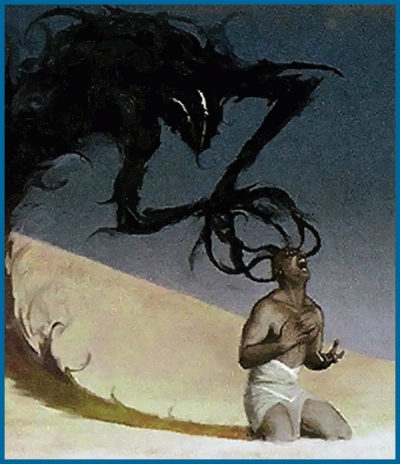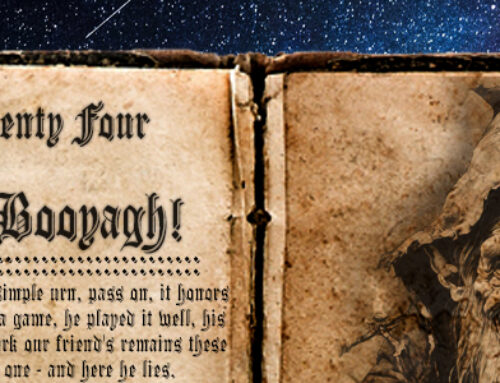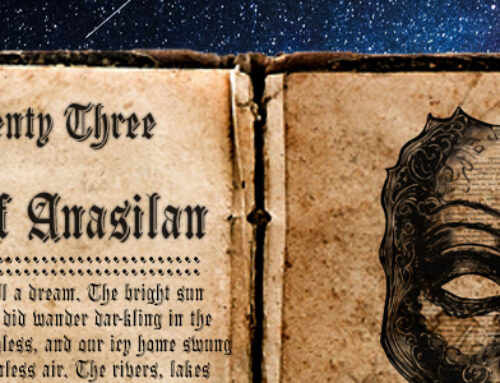Encounter ideas for a character arc revolving around the theme of mind control and hiveminds
The following blogpost is meant to give all you GMs and DMs out there some encounter ideas on how to use mind control in your campaign. All of these ideas can be downloaded as .pdf below.
Overview
Premise
Mind control has been part of RPGs like Dungeons and Dragons since the very beginning. However, they mostly took the form of mostly not very fun mechanics, e.g. like spells that change alignment (AD&D) or things like “mind rape” (D&D 3.5) that could permanently alter how a player thinks. These things all take agency away from the player and usually don’t make for a very enjoyable experience. Games with sanity mechanics like “Call of Cthulhu” usually fair a bit better in this regard – as characters may just get more corrupted by an idea over time.
The following encounter ideas all centre around the theme of mind-control and the possible interesting situations that could arise from them. They follow an arc from “just a bit influenced” to “under almost complete mind control”. They are meant to give you GMs out there an idea, on how to approach mind control or a foreign consciousness invading players’ minds in your campaign.
Part 1: Getting influenced
The key to success with any arc about mind control or insanity is to build it up slowly. The following encounter ideas are meant to plant a seed of control or insanity. They aren’t ordered, just run any scenario you’d find interesting for your campaign.
Seeing beyond
The first contact with a hivemind or a being able to control your thoughts usually comes in the form of something allowing a player to experience a small part of said consciousness for him or herself.
For example: The party is fighting a bunch of crazed cultists. They aren’t a big deal to dispose of, but it was weird how they fought without any regard for their own life. One of the cultists the party thought dead suddenly jumps up and throws a player to the ground. He injects (or enchants) the player with some unknown magic, which causes him to fall unconscious. While the party fights the remaining cultist, hand the unconscious player a note with some flavour text. Maybe something like this:
“The entity known as PLAYERNAME is dead. In fact, it came to the realisation that it never really existed. There never was such a thing as PLAYERNAME – just matter that deluded itself into thinking it was separate from everything around it. Before PLAYERNAME’s demise, he saw something else – a true consciousness, a being observing this world without being part of it. It had the appearance of ADD SYMBOL OF ENTITY OF YOUR CHOICE HERE.”
After the fight is finished, take the note away from your player and tell the entire table, that he begins to slowly wake up. Don’t use any game mechanics to reflect the changes brought on by this encounter yet.

Parasitic hivemind
An alternate scenario could be getting poisoned or infected with a hivemind or mind control virus. It could play out like this: The party is dungeon crawling and they come across a small room with an object (a religious symbol, ancient tablet, etc.) attached to a pedestal in the middle of the room. There’s nothing else in the room. As soon as one of the players touches the object hand him a note reading something like this:
You feel your hand fuse with the OBJECT. You can’t move away from the pedestal. You want to scream in horror, but your body doesn’t seem to obey you anymore. Something is invading your mind, telling you to convince your party members to leave the room without raising suspicion. You suddenly know, that if you don’t manage to get them out of here, all of you will die. But you also know, that the foreign entity in your brain won’t allow you to reveal its presence to the others. Get them out and defend the OBJECT – if necessary with force.
While the player is reading, tell the other players that they see him studying the object closely, as if reading an inscription. If they really leave him alone, have the object melt into the players body. Maybe you even want to reinforce the idea of infestation with some mechanics (e.g. permanently lowered intelligence but increased wisdom). If they manage to pry him away from the object, you can just punish him with damage. The decision if this stopped the infestation is up to the GM.
Part 2: Slowly losing your mind
Mind control in most RPGs comes down to a spell or an enchantment that makes the player do things he doesn’t want to do. What we’re trying here is a bit more nefarious: It’s a foreign intelligence slowly gaining control over the player’s mind. These are some ideas on how to approach that concept.
Doubting your senses

Gradually begin using game mechanics to hint towards a bad case of mind control. The trick is to be subtle about it. For example, you could use perception or insight rolls. Let’s say the influenced player tries to interrogate an NPC and rolls intimation or insight, only to receive cryptic information which that NPC couldn’t possibly know. The other players didn’t hear anything. Alternatively, let the player mistake faces of NPCs or feel at ease around some dangerous monsters.
Such mind tricks can also work their way into combat – let the inflicted player use his reaction to block an attack from an unseen attacker or tell the player that he perceives the corpses moving, etc. Whatever fits your campaign. Just be careful not to overdo it, or good players will catch on immediately to what is going on.
Mysterious progress
Reward the inflicted player with mysterious progress that would benefit the mind controlling entity’s plans. All of these “rewards” should just look like dumb luck or incompetence on the GM’s part. For example, the inflicted player doesn’t seem to get attacked as much as the others, his perception checks reveal hidden doors with some regularity and he never seems to spring any traps. Even some NPCs are only willing to talk to the inflicted player.
Insane outside the game
This idea kind of depends on how your group works. If you have an experienced RPG group, you can probably just tell the inflicted player, that his character is having nightmares and hearing voices (or something similar). Have him hide it from the group and just act accordingly.
A softer approach could be asking the party outside of the game to send you their character’s internal motivation in a short-written paragraph. Then either discuss the motivation with the inflicted player to subtly influence them or use that information to guide his actions in game (e.g. maybe suddenly the NPCs seem to know exactly what he wants).
Part 3: Included in a neural network
Ideally, the part about getting influenced should be stretched over many play-sessions. Once your party enters the last third of your planned campaign, begin to suddenly escalate the situation.
The hills have eyes
NPCs always seem to be one step ahead of the party. They know what the inflicted player knows and act accordingly. Maybe they even mockingly start using phrases the inflicted player has used while discussing battle strategy.
The foreign influence over the inflicted players mind has grown so strong, that it is now able to see through his eyes.

Visions of your adversary
The neural connection the inflicted player shares with the controlling entity doesn’t have to be just one way. In irregular intervals, give him the opportunity to roll a wisdom saving check (or similar) and give him visions about what your enemies are doing. This works especially well if you only tell him this in private or with small notes during the game. Never show the other players, what you are telling him.
Two – way connection
The mind control connection can also be used by the player. Once the player picks up on what is happening to him, he may be able to use the connection to glean information directly from the enemies’ mind or even controlling the lesser parts of a hivemind himself.
With newer players, this is especially fun to do with little notes that you hand to the inflicted player. Stuff like:
You feel like you know this creature before you. Its’ mind is franticly clawing at your awareness. You concentrate and feel your mind connecting to it. Maybe if you concentrate hard enough, you can order it to do your bidding. Roll a wisdom saving throw.
Afterwards, depending on his roll, give him a few notes with possible commands for that creature on it. If he starts abusing that power hand him another note reading something like:
As you order the creature to do your bidding, you feel the spark of a foreign intelligence on the edge of your awareness. Are you being watched from afar?
This is meant as warning – if he continues to overuse the neural network, begin spawning stronger creatures that are part of the hive mind / neural network. Always take the notes away after the player has read them. He can talk about it in character, but the other players will still be curious and wary if he’s telling the truth.
Part 4: The hivemind
By now, most players will know what’s up or at least suspect that something is wrong. Therefore, it’s important that they are now stuck in situation where they can afford to leave the inflicted player behind (e.g. in a dungeon). As a GM, you can now stop being subtle about it.
Unexpected ally
Now you must get into the mechanics of mind-control – especially relating to combat. These are just some suggestions on how to do this:
- Being charmed in combat – i.e. the inflicted player not being able to harm the monster
- Disadvantage on attack rolls
- Monster has advantage on saving throws from the inflicted player
- Mistaking targets – the inflicted player suddenly sees his comrade’s face on the monster and vice-versa.
Maybe don’t use all these mechanics in a single battle – make them more common as they reach the centre of the hivemind’s power.
Full-blown betrayal?
Finally, the party reaches the entity responsible for the mind control magic. Hand your inflicted player another note reading something like this:
You know this strange creature. It is not your enemy, you are allies – part of the same consciousness. The people by your side are the real invaders. They must die – even if it costs you your life. These thoughts feel true. Yet, you sense a faint doubt somewhere in your subconscious. Each turn you can make a wisdom saving throw to gain a better understanding of that doubt in your mind. On a successful throw, you recognize your parties faces and can use your other actions however you see fit. On a failed throw, you regain your action and attack the intruders.
The resulting fight usually is a thing of beauty. If you want to go all out, maybe even give the inflicted player some buff when attacking his partner.
The mind control is only broken, if every bit of the hivemind has been killed.
Final Part: Now what?
It is important to reward the inflicted player, should he survive the ordeal. Maybe have him gain some hidden knowledge about the world or a custom-made feat.
And maybe, a few game-sessions down the line, have him feel the presence of the hivemind once again. However, this time, he’ll be ready to take the fight to it.






